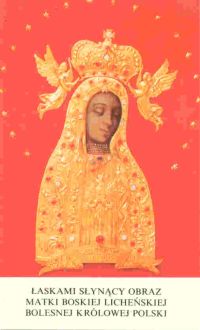Our Lady of Lichen
Our Lady of Lichen
Q: Can you provide me with information and the image of the Virgin of Lichen/Poland?
A: The sanctuary is located in Wielkopolska in a village called Lichen. It is located in southwestern Poland within traveling distance of Jasna Gora, (Mother of God of Czestochowa) and is one of Poland's important pilgrimage and apparition sites.
The history of the sanctuary dates back to 1813, when 'the battle of nations' took place near Leipzig. Polish soldiers were fighting under Napoleon, among them Tomasz Klossowski who was seriously wounded. Facing death, he began to invoke Our Lady, begging her not to let him die in a foreign land.

According to the legend, Our Lady was wearing a crown, an amaranth dress and a golden mantle. She appeared to him holding a white eagle in her right hand. She comforted the soldier and promised he would recover and return to Poland. Moreover, she asked him to find a picture in her likeness and to make it known in his homeland. The healed soldier returned to his home near Lichen. Year after year he wandered about the countryside searching for the miraculous image of Our Lady. In 1836 he eventually found it in Lgota. At first he placed the portrait in his own house, and then hung it up on an old pine-tree in the nearby forest--puszcza grablinska.
In 1850 the Holy Virgin revealed herself to the shepherd Mikolaj Sikatka who was pasturing cattle near the image in the forest. In her message to Mikolaj, Our Lady summoned people to conversion, to break with greed and licentiousness. She exhorted them to pray the rosary and reminded them to participate in celebration of the Sunday liturgy. She asked priests to celebrate the liturgy worthily. Finally, she also requested that her image be moved to a more fitting place. She promised that those who earnestly prayed before it would escape death during the plague, which was to be the punishment for the lack of conversion of sinners. Furthermore, the Holy Virgin predicted the foundation of the sanctuary and the monastery in Lichen, from where her glory would be made known. Mikolaj, the poor shepherd, started to spread Our Lady's message, but he was persecuted and imprisoned by the Russian invaders. At first, people wouldn't believe him. Only two years later, when, according to Mary's prophecy, the cholera epidemic broke out, they remembered her warning. Then people flocked to the image of the Holy Virgin to pray the rosary for the sick and dying.
A special episcopal committee examined the apparition. At the request of the parish priest, Florian Kosinski, the committee decided to move the portrait to the parish church in Lichen. This took place on September 29, 1852. Until 1939, three-thousand answers to prayers were recorded, among them miraculous recoveries. During World War II both the church and the rectory were confiscated and used by the Youth Nazi Organization. Fortunately, the image could be hidden and preserved.
In 1949 the parish of Lichen was entrusted to the Marian Fathers (i.e. the Marians of the Immaculate Conception, who run the National Shrine of the Divine Mercy in Stockbridge, MA). They started restoring the sanctuary damage incurred during the war. It took until 1967 when, on the Feast of the Assumption of the Holy Virgin, Cardinal Stefan Wyszynski, then Primate of Poland, crowned the miraculous image of Our Lady of Lichen, in the presence of the Ordinary of the Wroclawska Diocese, Bishop Antoni Pawlowski. Many other bishops, hundreds of priests, religious, and about 150,000 lay people attended the ceremony.
The number of pilgrims has been increasing ever since. During their stay in Lichen, the majority of pilgrims go to confession, for the mission of this pilgrimage place seems to be reconciliation with God. Thanks to pilgrims' generosity, a new Sanctuary of Our Lady of Lichen was built in remembrance and thanksgiving for the two-thousandth anniversary of the birth of Jesus Christ. Pope John Paul II blessed Poland's largest church on June 7, 1999. The church, modeled after Saint Peter's Basilica in the Vatican, is the seventh largest in Europe.
All About Mary includes a variety of content, much of which reflects the expertise, interpretations and opinions of the individual authors and not necessarily of the Marian Library or the University of Dayton. Please share feedback or suggestions with marianlibrary@udayton.edu.
